| |
|
 The Problem The Problem  What You Can Do What You Can Do  Links Links  Sample Letter to Editor Sample Letter to Editor 
 Printer-Friendly Fact Sheet
(PDF) Printer-Friendly Fact Sheet
(PDF)  Acrobat Reader Acrobat Reader 
|
| |
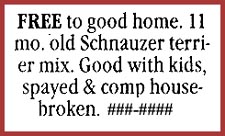 Shelters and rescues are
frequently criticized for charging an adoption fee. "If you're so anxious
to find homes for these pets," we're told, "you should just give them
away." Shelters and rescues are
frequently criticized for charging an adoption fee. "If you're so anxious
to find homes for these pets," we're told, "you should just give them
away."
This attitude
makes us shudder. In the first place, these small fees in no way begin to cover
the cost incurred for medical treatment and upkeep of the pets we adopt out.
Yes, we're anxious to find homes for our animals-- GOOD homes. And many people
who take free pets do provide wonderful homes. However, frequently -- much too
frequently! -- animal welfare workers are called in to rescue former "free
to good home" animals.
 Did you know: Did you know:
1. People value what they pay for.
Pets obtained for free are less likely to be spayed or
neutered by their new owners (why bother with vet bills?), and more
likely to be abused and/or discarded, because "there are plenty more where
that came from!" A recent study at one animal shelter yielded the
startling statistic that 51% of all owner-surrendered dogs had been purchased
for less than $100; 41% of all owner-surrendered dogs had been obtained
"Free to good home."
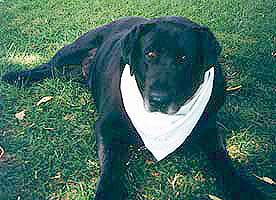 This handsome,
well-fed-looking fellow is Brutus, and he was spokes-dog for a dog and cat
rescue organization for many years. Brutus started life as the pampered friend
of "Mark." Brutus and Mark played ball together and walked on the
beach together, and, in general, enjoyed each other's company. Then, Mark's
company transferred him to a different state. Mark didn't know how to take
Brutus with him, or considered it unfair to submit his friend to the trauma of
moving, or just plain didn't know that most states DO allow big, good-natured
dogs to move in with their masters. This handsome,
well-fed-looking fellow is Brutus, and he was spokes-dog for a dog and cat
rescue organization for many years. Brutus started life as the pampered friend
of "Mark." Brutus and Mark played ball together and walked on the
beach together, and, in general, enjoyed each other's company. Then, Mark's
company transferred him to a different state. Mark didn't know how to take
Brutus with him, or considered it unfair to submit his friend to the trauma of
moving, or just plain didn't know that most states DO allow big, good-natured
dogs to move in with their masters.
Whatever the
reason, Mark placed an ad in his local newspaper: "Free to good home,
friendly, lovable black lab." Someone saw the ad, called Mark, and said,
"That's just the dog I've been looking for. Can I come over and see
him?" The new person was very nice to Brutus, talked to him, rubbed his
ears just the way Brutus liked to have his ears rubbed, and convinced Mark that
he and Brutus were just made for each other.
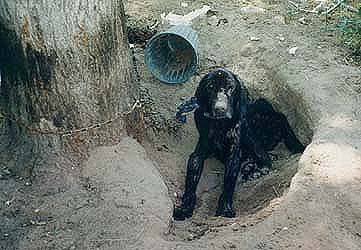
This is
Brutus's new owner's idea of a good home--at the end of a two-foot chain
tied to a rope collar, in a garbage-filled backyard, no water dish or food bowl
anywhere in sight. This sweet, loving dog was now 20 pounds underweight,
suffering from dehydration, malnutrition, fleas, intestinal worms, mange,
fly-chewed ears, heartworm, and, worst of all, neglect.
Luckily for
him, neighbors reported the situation. Police and animal welfare rescuers
arrived and Brutus was confiscated. The new owner was arrested, charged, and
convicted with cruelty to animals. He paid a fine which probably equaled less
than Brutus's medical bills.
Brutus went
to the vet for all kinds of medicine, then home with the rescuer for lunch.
Several years later, he's been adopted by the volunteer, and still eating! He's
well and happy and a bit overweight; greets everyone with a tail wag and a wet
kiss. But he still wants you to remember this story and this photo every time
you see an ad that says, "Free to good home."
|
| |
Author's Note: Brutus,
our "Free To Good Home?" poster dog, went to the Rainbow Bridge on 27
February 2002. We estimate his age at 13 years; he lived the last 6 of them in
the lap of luxury with his rescuers. Brutus was a favorite visitor at area
schools, and touched the hearts of everyone who met him. We will all miss him.
 Brutus's
Memorial Brutus's
Memorial 
|
|
| |
Top
|
| |
2. So-called "Bunchers" gather
free pets until they have enough for a trip to a Class B Dealer who is licensed
by the USDA to sell to sell animals from "random sources" for
research.
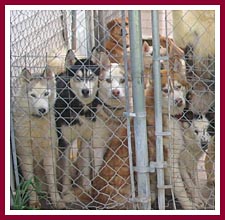 The Buncher may
only get $25 a head for former pets, while a dealer can between $100 - $450 per
pet. The Class B dealer probably already has a contract with certain
facilities, and will transport them to other areas within a state, even out of
state. The Buncher may
only get $25 a head for former pets, while a dealer can between $100 - $450 per
pet. The Class B dealer probably already has a contract with certain
facilities, and will transport them to other areas within a state, even out of
state.
While,
unfortunately, there are legitimate medical reasons to use some animals in
experimentation, the majority of reputable medical labs use animals bred for
the specific purpose. However, there are many, many different types of animal
"research," and many types of facilities that use dogs. Almost every
cosmetic, household, and chemical product is tested on animals, including
former pets obtained from shelters and Class B Dealers. Veterinary schools and
medical schools, and even some engineering schools use dogs and cats in
classrooms and "research." Textile manufacturers who make products
for medical use test and demonstrate on dogs.
Research
facilities that use live animals in testing are supposed to be registered with
the USDA (though not all are); please see the USDA License and Registration
lists on their website to see how many facilities use animals for
"research" or product testing in your state. (Please note that not
all of these use dogs or cats!)
 USDA/
APHIS Animal Welfare Act website USDA/
APHIS Animal Welfare Act website 
|
| |
Top
|
| |
3. Free animals are taken to
"blood" pit-bulls & other fighting dogs -- to train them how to
kill, and to enjoy it.
This
can be dogs and cats, of any size. Often, a larger dog's muzzle will be
duct-taped shut so that he can't bite back, and the fighting dog will gain
confidence in killing a dog larger than he is.
|
| |
Top
|
| |
4. One "adoptor" was blacklisted
by shelters and rescue organizations, so he took free kittens to his "good
home"--as dinner for a pet snake.
|
| |
Top
|
| |
5. Unspayed or unneutered pure-bred dogs
may end up as "breeding stock" in a puppy mill.
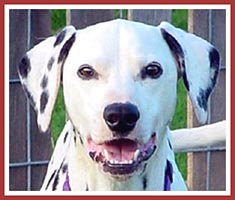 There is nothing sadder
for rescuers than to come across a mill breeder who has been a former pet.
Imagine being loved, pampered, well-fed, and cherished, then ending up in a
tiny cate with wire mesh under your feet, getting little food and no loving
attention. Forced to "service" female after female if you are a male
dog, and forced to produce litter after litter of puppies if you are a female.
Nothing is worse than betrayal of trust -- these animals loved and trusted
their former owners to look out for their well-being, and instead, those former
owners unknowingly condemned them to a life of torture in the mills. There is nothing sadder
for rescuers than to come across a mill breeder who has been a former pet.
Imagine being loved, pampered, well-fed, and cherished, then ending up in a
tiny cate with wire mesh under your feet, getting little food and no loving
attention. Forced to "service" female after female if you are a male
dog, and forced to produce litter after litter of puppies if you are a female.
Nothing is worse than betrayal of trust -- these animals loved and trusted
their former owners to look out for their well-being, and instead, those former
owners unknowingly condemned them to a life of torture in the mills.
One woman
told us she believed that if she didn't give away her Dalmatians' AKC
registration papers along with the dogs, she could keep them safe from millers.
Wrong.
Unscrupulous breeders, who use puppies as cash crops like other farmers raise
cattle, pigs, or chickens, aren't above forging registration papers, or using
those from deceased dogs, or making up their own "breed registries"
so that they can claim the puppies they sell have "papers." Rescuers
have learned the hard to way to make sure that all pets they place have been
spayed or neutered before going to new homes.
 What Does Breed Registration Really
Mean? What Does Breed Registration Really
Mean? 
|
| |
Top
|
| |
6. Animal hoarders watch the newspapers for
Free to Good Home animals.
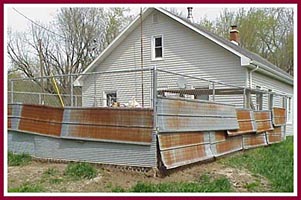 The scary thing is, these collectors truly believe they
are "rescuing" the animals, and will even pose as rescuers to take
animals out of shelters! The events described below took place in a small town
in Michigan, but animal hoarders can be found in all geographic locations and
all levels of society. See the Drive
To Save Lives! section of this website for a hoarder situation that
Wisconsin Puppy Mill Project was involved in two years ago. (And, by the way,
because of WI's lax laws, the hoarder described in that section bought himself
a "kennel license" and is hoarding dogs again!)
The scary thing is, these collectors truly believe they
are "rescuing" the animals, and will even pose as rescuers to take
animals out of shelters! The events described below took place in a small town
in Michigan, but animal hoarders can be found in all geographic locations and
all levels of society. See the Drive
To Save Lives! section of this website for a hoarder situation that
Wisconsin Puppy Mill Project was involved in two years ago. (And, by the way,
because of WI's lax laws, the hoarder described in that section bought himself
a "kennel license" and is hoarding dogs again!)
When the two
animal rescue volunteers and the policeman walked up the steps of an
ordinary-looking house in Galien, MI, they had no idea they were walking into a
living hell.
Neighbors had
complained about foul smells coming from the house; the owner, they said, kept
dozens of cats in there, but they hadn't seen her in a couple of weeks.
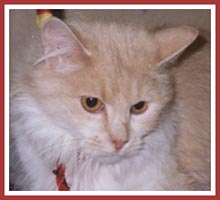 The place smelled, all
right; a strong odor assaulted their noses the minute they got out of the car.
Still, nothing in their experiences could have prepared them for what stunned
their senses as they opened that front door: the unimaginable sights and
silence and stomach-churning stench of mass death. Light was dim, and they saw
trash all around--trash, and bodies. The owner of the house had simply locked
the doors and windows and left dozens of cats behind with no food or water, to
die. The only thing that kept the volunteers from collapsing in despair were
faint rustles, scratches, mews, coming from just out of sight around the
corner. There were still live cats in this house of horrors. The place smelled, all
right; a strong odor assaulted their noses the minute they got out of the car.
Still, nothing in their experiences could have prepared them for what stunned
their senses as they opened that front door: the unimaginable sights and
silence and stomach-churning stench of mass death. Light was dim, and they saw
trash all around--trash, and bodies. The owner of the house had simply locked
the doors and windows and left dozens of cats behind with no food or water, to
die. The only thing that kept the volunteers from collapsing in despair were
faint rustles, scratches, mews, coming from just out of sight around the
corner. There were still live cats in this house of horrors.
Estimates
range from 40 - 60 as the number of cats this lady had abandoned; it was
impossible to tell for sure. Over the next few days, volunteers trapped and
removed all of the live animals they could find. There were 18, in a wide range
of ages, and of these, two later died.
All of them
were starving, dehydrated, and totally unsociable. They had survived the only
way they could, by preying on the small, the weak, the sick, and the dead.
Rescued kittens lived in fear of adult cats; adult cats lived in fear of each
other--and of human contact.
Meanwhile, a
warrant was issued for the arrest of the house's owner, and the entire area was
outraged to learn that this was her THIRD offense! The THIRD time she had
"collected" a house full of cats, and then abandoned them, the SECOND
time in this very same house!
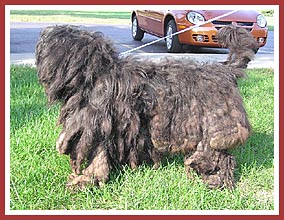 How could this happen?
It's not as unusual as you might believe--or hope. Such people are called
"animal hoarders;" they take in orphaned dogs or cats, watch the
"free to good home" ads, either don't believe in spaying and
neutering or run out of funds for the vet bills. These hoarders actually think
they are "rescuing" the animals! More and more free pets come to
them--they're very convincing; and they truly do love pets--and the ones they
have keep reproducing, until the hoarders are overwhelmed. In the best
circumstances, animal rescue organizations are called. In the worst--the
hoarder simply walks away. How could this happen?
It's not as unusual as you might believe--or hope. Such people are called
"animal hoarders;" they take in orphaned dogs or cats, watch the
"free to good home" ads, either don't believe in spaying and
neutering or run out of funds for the vet bills. These hoarders actually think
they are "rescuing" the animals! More and more free pets come to
them--they're very convincing; and they truly do love pets--and the ones they
have keep reproducing, until the hoarders are overwhelmed. In the best
circumstances, animal rescue organizations are called. In the worst--the
hoarder simply walks away.
The owner of
the "Galien Hell House" was located in another state, and brought
back for trial. She will serve jail time, pay a fine, do community service, but
there is no guarantee that when her sentence is served, she won't simply move
to another house in another community in another state, and start answering
"Free to good home" ads again.
As for the
police, the neighbors, and especially the volunteers involved in the rescue of
the Galien kitties--they're still having nightmares.
A case of Animal Hoarding in
Wisconsin:
 Drive To Save Lives! Drive To Save Lives! 
More information on Animal Hoarding:
 Animal Hoarders Animal Hoarders 
|
| |
Top
|
| |
 WHAT CAN YOU DO? WHAT CAN YOU DO?
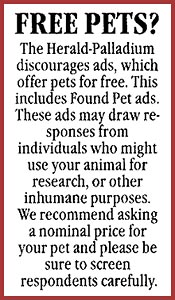 Some folks answering the
"Free to Good Home" ads really are loving, responsible pet owners.
Many are not. There are steps YOU can take to help end abuse: Some folks answering the
"Free to Good Home" ads really are loving, responsible pet owners.
Many are not. There are steps YOU can take to help end abuse:
DON'T advertise Free pets; DO
convince others not to. Some people even take the time to phone owners of pets
advertising Free to Good Home and warn them of the dangers.
DO ask your local newspapers to quit
accepting, or at least actively discourage, Free To Good Home ads.
DO write letters to the editors of your local
newspapers warning of the dangers of Free to Good Home. (Click here
for Sample Letter to Editor.)
DO spay/neuter to keep from
creating possible Free to Good Home situations or condemning your pet to a
short, miserable life in a puppy mill.
-
DO contact breed rescue organizations (there is one for
every breed of pure-bred dog!) or local animal welfare organizations for help
in placing unwanted pets; if you bought the pet from a responsible breeder,
he/she will help you rehome the pet.
DO charge at least $25 to discourage resale of pets to
labs. (Some sources suggest charging no less than $100 for pure-bred dogs.)
DO take the time to interview every prospective owner.
Ask for vet and personnel references, and check them, then visit the new home
where your pet might be living!
DO write a letter to your state and federal
representatives in support of animal protection legislation, aimed at
regulating puppy mills, cracking down on animal fighting, and doing away with
Class B dealers, who sell animals obtained from "random sources" to
research facilities. Random sources include strays, stolen pets, seized shelter
animals, animals purchased at flea markets--and pets found through "Free
to good home" ads.
DO report any incidence of suspected dog-fighting to
police, Animal Control, and your local Humane Society. DON'T try to stop these
people yourselves; there is a lot of money involved here, and you could be
putting yourself and your pets at risk if you try to intervene alone.
-
DO call police, animal welfare workers, even the health
department, if someone in your area seems to be "collecting" cats or
dogs.
DO write to district attorneys, judges, and prosecutors
if you hear of the arrest of any so-called collectors in your area, and urge
them not only to prosecute to the full extent of the law, but also to mandate
psychological counseling for these individuals in the hopes of avoiding repeat
violations.
DO call police or animal welfare workers for any
incidences of suspected abuse. Be willing to testify in court, if necessary.
Note: what constitutes animal abuse is defined by state law. If your state has
inadequate abuse laws, TRY TO CHANGE THEM!
DO take a look at
First Strike brochure (pdf) and related articles on the
HSUS website for information and resources detailing the links between cruelty
to animals and violence against humans, and share them with the appropriate
agencies in your area.
Remember--the welfare of pets is in ALL of our hands!
|
| |
Top
|
| |
 HELPFUL LINKS: HELPFUL LINKS:
|
|
| |
|
 Printer-Friendly Fact Sheet
(PDF) Printer-Friendly Fact Sheet
(PDF)  Acrobat Reader Acrobat Reader 
|
| |
If you would like to reproduce the information contained in this article,
please contact our Webmaster.
|
|
| |
Home * About
WPMP * Contact Us * Site
Search * Donate
What is a Puppy
Mill? * Puppy Mill Survivors * Photo
Album * The Petstore Connection
Dog
Auctions * Animal
Hoarding * What YOU Can Do
Laws/Legislation * Act 90/S.173.41/ WI Dog Program
* Filing a Complaint Against a WI Dog Seller
Guide to Finding a
Pet * Breeders With Pride * Rehoming: Free To Good Home?
©
Copyright, 2008. The Wisconsin Puppy MIll Project
P.O. Box 926 * Sheboygan, WI
53082-0926 * info@NoWisconsinPuppyMills.com
Article Copyright © 1999
- 2008 by Michelle E. Crean All Rights Reserved. Used with permission.
Brutus Photos Copyright © 1999, by Cindy Bravender. All Rights Reserved.
Used with permission.
"Galien Cats" photos Copyright © 1999, by Sue Burkhard. All
Rights Reserved. Used with permission
"Dice" dalmatian photo Copyright © 2002, by
Rocky Spot Rescue. All
Rights Reserved. Used with permission.
Hope the hoarder dog Copyright © 2005, by Pat Crean. All Rights Reserved.
Used with permission.
Other photos Copyright © 2006, by Wisconsin Puppy Mill Project. All
Rights Reserved. Used with permission.
Website design by
Hook & Web
Designs
|

 Shelters and rescues are
frequently criticized for charging an adoption fee. "If you're so anxious
to find homes for these pets," we're told, "you should just give them
away."
Shelters and rescues are
frequently criticized for charging an adoption fee. "If you're so anxious
to find homes for these pets," we're told, "you should just give them
away." This handsome,
well-fed-looking fellow is Brutus, and he was spokes-dog for a dog and cat
rescue organization for many years. Brutus started life as the pampered friend
of "Mark." Brutus and Mark played ball together and walked on the
beach together, and, in general, enjoyed each other's company. Then, Mark's
company transferred him to a different state. Mark didn't know how to take
Brutus with him, or considered it unfair to submit his friend to the trauma of
moving, or just plain didn't know that most states DO allow big, good-natured
dogs to move in with their masters.
This handsome,
well-fed-looking fellow is Brutus, and he was spokes-dog for a dog and cat
rescue organization for many years. Brutus started life as the pampered friend
of "Mark." Brutus and Mark played ball together and walked on the
beach together, and, in general, enjoyed each other's company. Then, Mark's
company transferred him to a different state. Mark didn't know how to take
Brutus with him, or considered it unfair to submit his friend to the trauma of
moving, or just plain didn't know that most states DO allow big, good-natured
dogs to move in with their masters. 
 The Buncher may
only get $25 a head for former pets, while a dealer can between $100 - $450 per
pet. The Class B dealer probably already has a contract with certain
facilities, and will transport them to other areas within a state, even out of
state.
The Buncher may
only get $25 a head for former pets, while a dealer can between $100 - $450 per
pet. The Class B dealer probably already has a contract with certain
facilities, and will transport them to other areas within a state, even out of
state.  There is nothing sadder
for rescuers than to come across a mill breeder who has been a former pet.
Imagine being loved, pampered, well-fed, and cherished, then ending up in a
tiny cate with wire mesh under your feet, getting little food and no loving
attention. Forced to "service" female after female if you are a male
dog, and forced to produce litter after litter of puppies if you are a female.
Nothing is worse than betrayal of trust -- these animals loved and trusted
their former owners to look out for their well-being, and instead, those former
owners unknowingly condemned them to a life of torture in the mills.
There is nothing sadder
for rescuers than to come across a mill breeder who has been a former pet.
Imagine being loved, pampered, well-fed, and cherished, then ending up in a
tiny cate with wire mesh under your feet, getting little food and no loving
attention. Forced to "service" female after female if you are a male
dog, and forced to produce litter after litter of puppies if you are a female.
Nothing is worse than betrayal of trust -- these animals loved and trusted
their former owners to look out for their well-being, and instead, those former
owners unknowingly condemned them to a life of torture in the mills. The scary thing is, these collectors truly believe they
are "rescuing" the animals, and will even pose as rescuers to take
animals out of shelters! The events described below took place in a small town
in Michigan, but animal hoarders can be found in all geographic locations and
all levels of society. See the
The scary thing is, these collectors truly believe they
are "rescuing" the animals, and will even pose as rescuers to take
animals out of shelters! The events described below took place in a small town
in Michigan, but animal hoarders can be found in all geographic locations and
all levels of society. See the  The place smelled, all
right; a strong odor assaulted their noses the minute they got out of the car.
Still, nothing in their experiences could have prepared them for what stunned
their senses as they opened that front door: the unimaginable sights and
silence and stomach-churning stench of mass death. Light was dim, and they saw
trash all around--trash, and bodies. The owner of the house had simply locked
the doors and windows and left dozens of cats behind with no food or water, to
die. The only thing that kept the volunteers from collapsing in despair were
faint rustles, scratches, mews, coming from just out of sight around the
corner. There were still live cats in this house of horrors.
The place smelled, all
right; a strong odor assaulted their noses the minute they got out of the car.
Still, nothing in their experiences could have prepared them for what stunned
their senses as they opened that front door: the unimaginable sights and
silence and stomach-churning stench of mass death. Light was dim, and they saw
trash all around--trash, and bodies. The owner of the house had simply locked
the doors and windows and left dozens of cats behind with no food or water, to
die. The only thing that kept the volunteers from collapsing in despair were
faint rustles, scratches, mews, coming from just out of sight around the
corner. There were still live cats in this house of horrors. How could this happen?
It's not as unusual as you might believe--or hope. Such people are called
"animal hoarders;" they take in orphaned dogs or cats, watch the
"free to good home" ads, either don't believe in spaying and
neutering or run out of funds for the vet bills. These hoarders actually think
they are "rescuing" the animals! More and more free pets come to
them--they're very convincing; and they truly do love pets--and the ones they
have keep reproducing, until the hoarders are overwhelmed. In the best
circumstances, animal rescue organizations are called. In the worst--the
hoarder simply walks away.
How could this happen?
It's not as unusual as you might believe--or hope. Such people are called
"animal hoarders;" they take in orphaned dogs or cats, watch the
"free to good home" ads, either don't believe in spaying and
neutering or run out of funds for the vet bills. These hoarders actually think
they are "rescuing" the animals! More and more free pets come to
them--they're very convincing; and they truly do love pets--and the ones they
have keep reproducing, until the hoarders are overwhelmed. In the best
circumstances, animal rescue organizations are called. In the worst--the
hoarder simply walks away. Some folks answering the
"Free to Good Home" ads really are loving, responsible pet owners.
Many are not. There are steps YOU can take to help end abuse:
Some folks answering the
"Free to Good Home" ads really are loving, responsible pet owners.
Many are not. There are steps YOU can take to help end abuse: